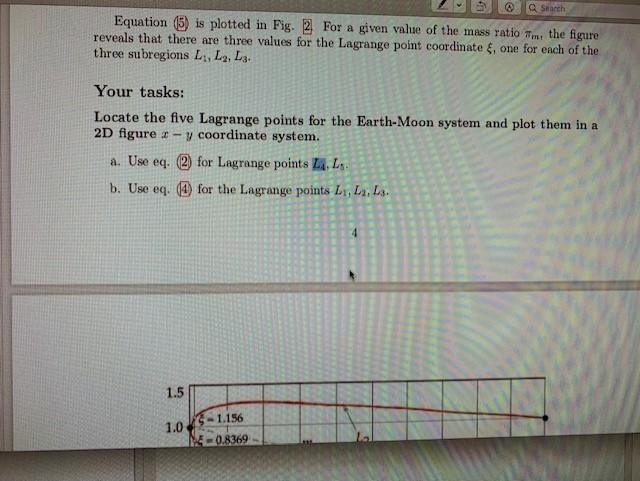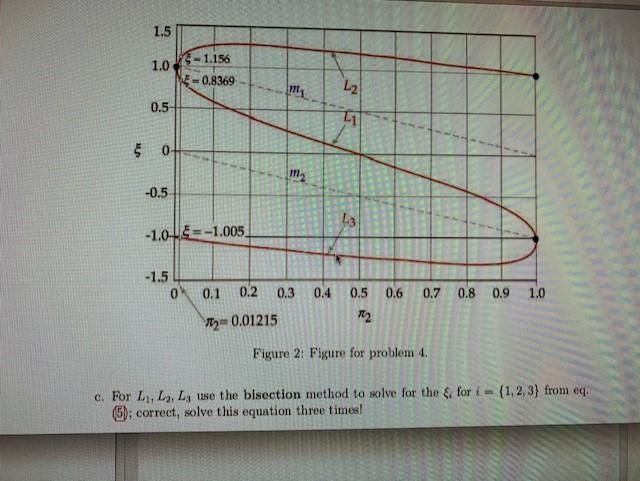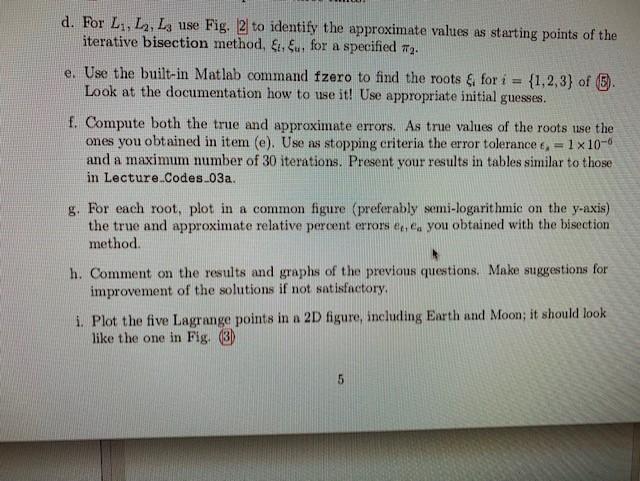



 MATLAB: Can you please help?
MATLAB: Can you please help?
a Search PROBLEM 4. points 40 - Use MATLAB Consider a circular restricted three-body problem (CRTBP) in which Earth me and Moon mg are moving under the action of just their mutual gravitation, and their orbit around each other is a circle of radius ra. There is also a third body, a spacecraft, of mass m, which is vanishingly small compared with the primary masses m, and my. Thus, the spacecraft mass m has no effect on the circular motion of Earth and Moon around each other. Among others, we are interested in the equilibrium points of m due to the gravitational fields of m and my. These points are the locations in space where the spacecraft m would have zero velocity and zero acceleration. Once placed at an equilibrium point (also called libration point or Lagrange point), the spacecraft will presumably stay there, Based on the orbit mechanics theory of the CRTBP, there are five Lagrange points. The coordinates of two of these points, labeled as LA and Lare given by the equations: T'ia V3 LA, LA VE 12: (2) 2 2 where ma T2 (3) mi mg The other three equilibrium (or Lagringo) points L., L.Ly are given by the coordinates: L La Ls: IN - Siri fori - {1,2,3) y = 0; =0 where the non-dimensional numbers & for i= {1,2,3) are the roots of the transcendental equation: & +12 &+ - 1 $(#, ) = (1 - 1) (5) 18 + 731 $ + #- 11 + Tm Search Equation (5) is plotted in Fig. 2 For a given value of the mass ration, the figure reveals that there are three values for the Lagrange point coordinate &, one for each of the three subregions L, L2, L3. Your tasks: Locate the five Lagrange points for the Earth-Moon system and plot them in a 2D figure - y coordinate system. a. Use eq. 2 for Lagrange points LA, LA b. Use eq. (4) for the Lagrange points Li, L.L. 4 1.5 -1.156 1.0 N=0.8369 1.5 1.0 5-1.156 -0.8369 L2 0.5 50 1913 -0.5 L3 -10-15=-1.009 -1.5 0 0.1 0.2 0.3 0.4 0.6 0.7 0.8 0.9 1.0 0.5 2 772-0.01215 Figure 2: Figure for problem 4. c. For Ly, Ly, Ly use the bisection method to solve for the & for i= {1,2,3} from eq. 6): correct, solve this equation three times! d. For L1, L2, L3 use Fig. 2] to identify the approximate values as starting points of the iterative bisection method, Ei. Eu, for a specified 72. e. Use the built-in Matlab command fzero to find the roots & for i {1,2,3) of ) Look at the documentation how to use it! Use appropriate initial guesses. f. Compute both the true and approximate errors. As true values of the roots use the ones you obtained in item (e). Use as stopping criteria the error tolerance 6,=1x10- and a maximum number of 30 iterations. Present your results in tables similar to those in Lecture.Codes_03a. g. For each root, plot in a common figure (preferably semi-logarithmic on the y-axis) the true and approximate relative percent errors e, c. you obtained with the bisection method h. Comment on the results and graphs of the previous questions. Make suggestions for improvement of the solutions if not satisfactory. i. Plot the five Lagrange points in a 2D figure, including Earth and Moon; it should look like the one in Fig. (3) 5 Q Search Use the following numerical values: m = 5.974 x 102 kg m2 = 7.348 x 10 kg 712 3.844 x 10 km Earth's mass Moon's mass distance between Earth and Moon x 10 The Five Lagrange Points of the Earth-Moon System 3 LI L2 3 L4 LS Earth Moon 1 0 el CI ci a Search PROBLEM 4. points 40 - Use MATLAB Consider a circular restricted three-body problem (CRTBP) in which Earth me and Moon mg are moving under the action of just their mutual gravitation, and their orbit around each other is a circle of radius ra. There is also a third body, a spacecraft, of mass m, which is vanishingly small compared with the primary masses m, and my. Thus, the spacecraft mass m has no effect on the circular motion of Earth and Moon around each other. Among others, we are interested in the equilibrium points of m due to the gravitational fields of m and my. These points are the locations in space where the spacecraft m would have zero velocity and zero acceleration. Once placed at an equilibrium point (also called libration point or Lagrange point), the spacecraft will presumably stay there, Based on the orbit mechanics theory of the CRTBP, there are five Lagrange points. The coordinates of two of these points, labeled as LA and Lare given by the equations: T'ia V3 LA, LA VE 12: (2) 2 2 where ma T2 (3) mi mg The other three equilibrium (or Lagringo) points L., L.Ly are given by the coordinates: L La Ls: IN - Siri fori - {1,2,3) y = 0; =0 where the non-dimensional numbers & for i= {1,2,3) are the roots of the transcendental equation: & +12 &+ - 1 $(#, ) = (1 - 1) (5) 18 + 731 $ + #- 11 + Tm Search Equation (5) is plotted in Fig. 2 For a given value of the mass ration, the figure reveals that there are three values for the Lagrange point coordinate &, one for each of the three subregions L, L2, L3. Your tasks: Locate the five Lagrange points for the Earth-Moon system and plot them in a 2D figure - y coordinate system. a. Use eq. 2 for Lagrange points LA, LA b. Use eq. (4) for the Lagrange points Li, L.L. 4 1.5 -1.156 1.0 N=0.8369 1.5 1.0 5-1.156 -0.8369 L2 0.5 50 1913 -0.5 L3 -10-15=-1.009 -1.5 0 0.1 0.2 0.3 0.4 0.6 0.7 0.8 0.9 1.0 0.5 2 772-0.01215 Figure 2: Figure for problem 4. c. For Ly, Ly, Ly use the bisection method to solve for the & for i= {1,2,3} from eq. 6): correct, solve this equation three times! d. For L1, L2, L3 use Fig. 2] to identify the approximate values as starting points of the iterative bisection method, Ei. Eu, for a specified 72. e. Use the built-in Matlab command fzero to find the roots & for i {1,2,3) of ) Look at the documentation how to use it! Use appropriate initial guesses. f. Compute both the true and approximate errors. As true values of the roots use the ones you obtained in item (e). Use as stopping criteria the error tolerance 6,=1x10- and a maximum number of 30 iterations. Present your results in tables similar to those in Lecture.Codes_03a. g. For each root, plot in a common figure (preferably semi-logarithmic on the y-axis) the true and approximate relative percent errors e, c. you obtained with the bisection method h. Comment on the results and graphs of the previous questions. Make suggestions for improvement of the solutions if not satisfactory. i. Plot the five Lagrange points in a 2D figure, including Earth and Moon; it should look like the one in Fig. (3) 5 Q Search Use the following numerical values: m = 5.974 x 102 kg m2 = 7.348 x 10 kg 712 3.844 x 10 km Earth's mass Moon's mass distance between Earth and Moon x 10 The Five Lagrange Points of the Earth-Moon System 3 LI L2 3 L4 LS Earth Moon 1 0 el CI ci




 MATLAB: Can you please help?
MATLAB: Can you please help?





